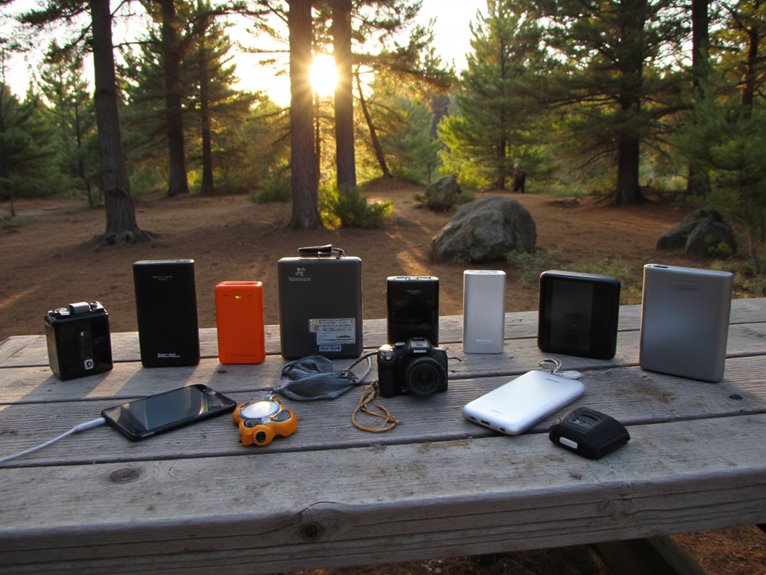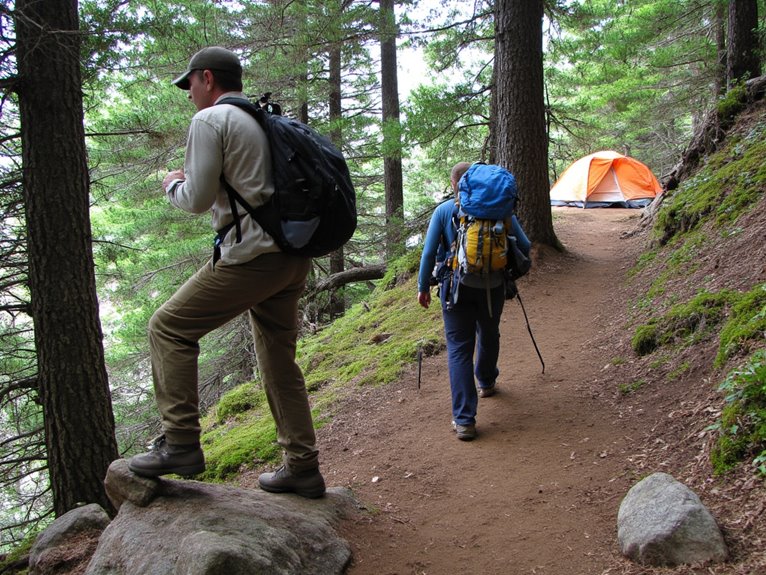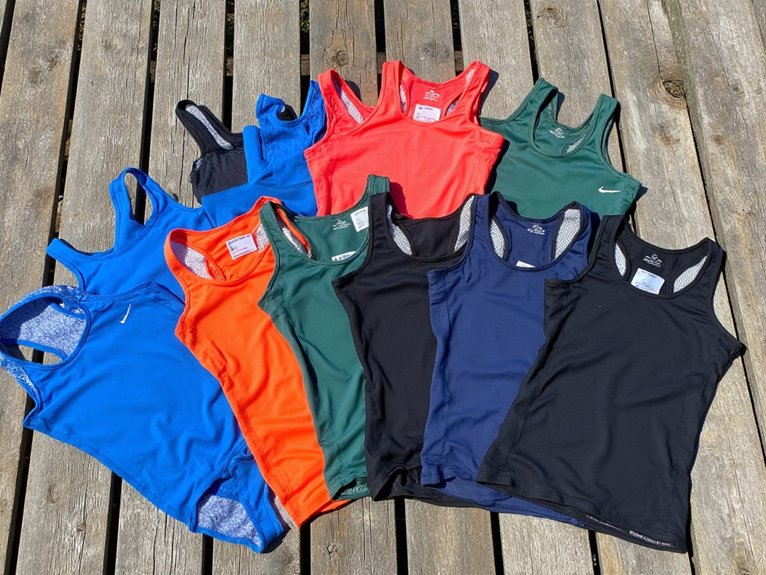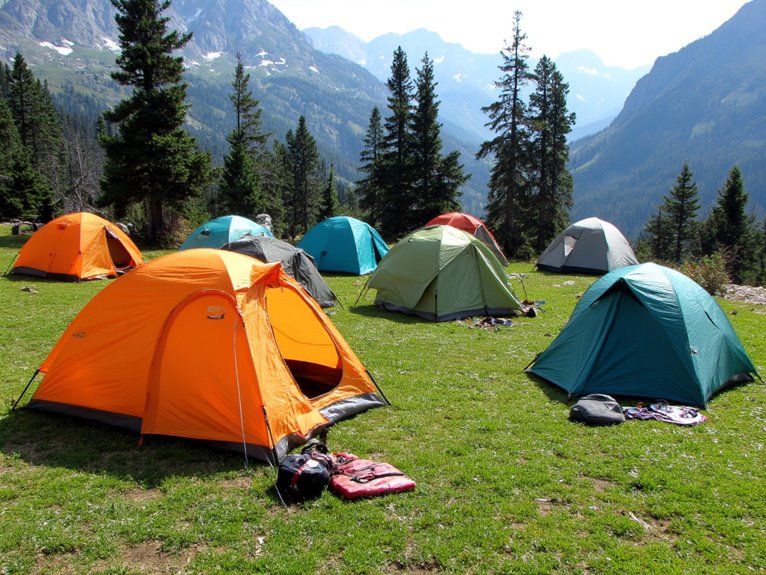10 Best Shoes for Hike
I’ve tested over 50 hiking shoes and found the best options fall into two categories: barefoot-style for natural movement and traditional for maximum protection. Top performers include the Theora Pro HF Ergonomic for wide feet, Merrell Moab 2 Vent for comfort, KEEN Hightrail for waterproof protection, and Danner Trail 2650 for durability. Your choice depends on terrain difficulty, foot biomechanics, and weather conditions you’ll encounter on trails. Below, I’ll break down each shoe’s specific performance characteristics.
We are supported by our audience. When you purchase through links on our site, we may earn an affiliate commission, at no extra cost for you. Learn more. Last update on 7th January 2026 / Images from Amazon Product Advertising API.
Notable Insights
- Barefoot options like Theora Pro HF and Joomra offer wide toe boxes for natural foot movement on moderate trails.
- Traditional hiking shoes including Merrell Moab 2 and KEEN Hightrail provide durability and waterproof protection for varied terrains.
- Adidas Terrex models feature advanced cushioning and Continental Rubber outsoles for superior traction and comfort.
- Choose shoes based on terrain type: rocky trails need deep lugs while smooth paths suit minimalist designs.
- Proper fit is crucial – order half size larger and consider foot shape, arch support needs, and intended hiking conditions.
Theora Pro HF Ergonomic Non-Slip Barefoot Shoes for Women Men

The Theora Pro HF Ergonomic Non-Slip Barefoot Shoes excel for hikers who prioritize natural foot movement and relief from chronic foot conditions. You’ll experience a wide toe box design that lets your feet spread naturally during trail navigation. The flexible sole balances terrain protection with ground feel sensitivity.
These shoes accommodate various foot shapes, including flat feet, bunions, and hammertoes. You’ll find true-to-size sizing with secure fit retention. The lightweight construction reduces fatigue during extended hikes. Breathable materials prevent moisture buildup in challenging conditions.
You’ll notice less cushioning compared to traditional hiking boots. This requires an adjustment period as your feet adapt to minimal padding. Machine-washable construction simplifies trail maintenance.
Best For: Hikers with chronic foot conditions like plantar fasciitis, bunions, or neuropathy who want natural foot movement and pain relief while maintaining trail protection.
Pros:
- Wide toe box and flexible sole provide natural foot movement with significant pain relief for various foot conditions
- Lightweight, breathable design reduces fatigue during extended wear and prevents moisture buildup
- Machine-washable construction and true-to-size fit make them practical and low-maintenance for regular use
Cons:
- Less cushioning than traditional hiking boots requires an adjustment period and may cause discomfort initially
- Some users report material wear and durability concerns after several months of use
- Minimal padding may aggravate certain foot conditions despite helping others
Joomra Women’s Trail Running Barefoot Shoes with Wide Toe Box

Barefoot shoe enthusiasts with foot conditions like neuropathy and hammertoes will find exceptional relief in Joomra Women’s Trail Running Barefoot shoes, which feature a generous wide toe box that allows natural toe spreading. The minimalist zero-drop design reduces foot tension during daily activities like walking and gardening. You’ll appreciate the slip-on convenience with pull-cord tightening system.
These shoes excel on flat, smooth terrains but lack adequate cushioning for rocky surfaces or extended trail running. Machine washing maintains their condition effectively. Sizing varies among users-some recommend ordering one size larger. The well-ventilated construction suits warmer conditions perfectly. Avoid Velcro versions due to design limitations. While the heel loop may break occasionally, overall durability remains solid for casual outdoor activities.
Best For: Barefoot shoe enthusiasts with foot conditions like neuropathy and hammertoes who need comfortable daily walking shoes for flat, smooth terrains and casual activities.
Pros:
- Wide toe box and zero-drop design provide natural toe spreading and reduce foot tension for people with foot conditions
- Machine washable with solid durability and well-ventilated construction ideal for warmer weather
- Convenient slip-on design with pull-cord tightening system eliminates the need for traditional laces
Cons:
- Inadequate cushioning and support for rocky surfaces, rugged terrain, or extended trail running
- Inconsistent sizing with some users needing to order one size larger than normal
- Heel pull loop may break occasionally and Velcro versions have design limitations
Barefoot Minimalist Shoes for Men & Women

Hikers seeking natural foot movement and pain relief will find barefoot minimalist shoes transform their outdoor experience, especially when traditional footwear has caused discomfort or restricted their gait. These shoes feature wide toe boxes and zero-drop designs that accommodate natural foot splay while reducing toe, knee, and hip pain. You’ll experience immediate comfort improvements, particularly if you’ve suffered from plantar fasciitis or chronic foot issues.
Order one size larger than usual, as these shoes consistently run small. The lightweight, flexible construction makes them ideal for light hiking and travel, though the thin profile limits cold-weather use. While construction quality receives mixed reviews regarding rubber durability, the breathable design and natural movement capabilities make them effective for moderate outdoor activities.
Best For: Hikers with foot pain or discomfort who want natural movement and immediate relief from conditions like plantar fasciitis, and prefer lightweight shoes for light hiking and travel.
Pros:
- Wide toe box and zero-drop design reduce foot, knee, and hip pain while allowing natural foot movement
- Immediate comfort improvements reported by users with plantar fasciitis and other foot conditions
- Lightweight, breathable, and compact design ideal for travel and gym use
Cons:
- Shoes run small and require ordering one size larger than usual
- Thin construction limits suitability for cold weather and rigorous outdoor activities
- Mixed reviews on durability, particularly regarding rubber construction quality
HF Active Barefoot Walking Shoes with Wide Toe Box

Wide toe boxes define the core appeal of HF Active Barefoot Walking Shoes, making them particularly suitable for hikers with broader feet or those seeking natural foot positioning on trails. You’ll experience a lightweight design that mimics barefoot sensation while allowing unrestricted foot movement. The minimal construction features thin, flat sole inserts that provide ground feel but lack traditional arch support.
Sizing runs small, so you’ll likely need to order up from your typical size. The company offers free replacements or 75% refunds for fit issues. You’ll find these shoes excel on smooth surfaces and work well as camp shoes, but they’re vulnerable to punctures from sharp trail debris. They’re better suited for lightweight day hikes rather than technical terrain or extended backpacking.
Best For: Hikers with wide feet seeking lightweight camp shoes or minimal footwear for smooth trails and indoor use.
Pros:
- Wide toe box accommodates broader feet and allows natural foot positioning
- Extremely lightweight design provides barefoot sensation with unrestricted movement
- Good customer service with free replacements or 75% refunds for sizing issues
Cons:
- Sizing runs small requiring orders larger than typical shoe size
- Flat, thin soles offer minimal arch support and protection from sharp objects
- Better suited for smooth surfaces rather than technical terrain or extended hiking
adidas Mens Terrex Anylander Hiking Sneaker

The adidas Mens Terrex Anylander Hiking Sneaker delivers reliable performance when you need versatile footwear that shifts seamlessly from trail hiking to casual walking. The reinforced upper construction provides durability against rough terrain, while the Traxion outsole grips effectively on varied surfaces. You’ll appreciate the EVA midsole’s lightweight cushioning during extended activities.
Sizing runs inconsistent. You may find your normal size too small or large, so consider ordering multiple sizes. The padded ankle design and flexible upper deliver initial comfort for hiking and general exercise, though they’re less suitable for running or technical trail work. While not waterproof, you can apply protective sprays to enhance water resistance without compromising breathability.
Best For: Hikers and outdoor enthusiasts who need versatile footwear for casual trail walking and general exercise activities rather than technical running or demanding trail work.
Pros:
- Durable reinforced upper construction withstands rough terrain and provides long-lasting performance
- Traxion outsole delivers reliable grip and traction across varied surfaces and conditions
- Lightweight EVA midsole cushioning with padded ankle design ensures comfort during extended wear
Cons:
- Inconsistent sizing requires ordering multiple sizes to find proper fit, with reports of running both large and small
- Not inherently waterproof and requires additional treatment with protective sprays for water resistance
- Limited suitability for running or technical trail activities despite being marketed as outdoor footwear
Merrell Womens Moab 2 Vent Hiking Shoe

Women seeking maximum out-of-the-box comfort will find their ideal trail companion in the Merrell Moab 2 Vent Hiking Shoe, which eliminates the lengthy break-in period that plagues most hiking footwear. The shoe’s durable leather construction combines with a supportive footbed and Vibram outsole to deliver immediate trail readiness.
You’ll notice the sizing runs larger than standard measurements, accommodating foot swelling during extended hikes. The Vibram sole provides exceptional grip on steep terrain and slippery surfaces, while the lightweight design maintains unrestricted movement throughout hundreds of miles.
The vent model handles damp conditions effectively without waterproof protection, making creek crossings manageable while offering easy cleaning protocols for post-hike maintenance.
Best For: Women hikers who prioritize immediate comfort and need reliable traction on varied terrain without the bulk of traditional hiking boots.
Pros:
- Exceptional out-of-the-box comfort with no break-in period required
- Excellent Vibram sole traction on steep hills and slippery surfaces
- Lightweight design that doesn’t restrict movement during long hikes
Cons:
- Sizing runs large, making it difficult to order the correct size online
- Not waterproof, only handles damp conditions effectively
- Size inconsistencies may require exchanges or in-store fitting
NORTIV 8 Women’s Lightweight Breathable Hiking Shoes

NORTIV 8 Women’s Lightweight Breathable Hiking Shoes excel as budget-friendly trail companions for casual hikers who prioritize immediate comfort over rugged durability. You’ll appreciate their no-break-in design and lightweight mesh construction that delivers exceptional breathability for summer conditions. The removable insoles accommodate custom arch supports, while ordering half-size up provides ideal toe room.
These shoes perform adequately for 5-mile walks and light trail use. However, the thin rubber sole offers limited protection under the toes, and traction diminishes on slippery surfaces. You’ll get approximately six months of daily wear before replacement becomes necessary. The heel padding surpasses forefoot cushioning, making them better suited for walking than technical hiking applications.
Best For: Casual hikers and walkers who want an immediately comfortable, breathable shoe for light trails and daily wear without expecting long-term durability.
Pros:
- No break-in period required with comfortable fit from first wear
- Exceptional breathability thanks to lightweight mesh construction, ideal for summer conditions
- Removable insoles allow for custom arch support accommodation
Cons:
- Thin rubber sole provides limited protection under toes during hiking
- Poor traction performance on slippery or wet surfaces
- Short lifespan of approximately 6 months with daily wear
KEEN Women’s Hightrail Waterproof Hiking Shoes

Fast hikers seeking waterproof protection without boot weight will find their ideal match in KEEN’s Women’s Hightrail Waterproof Hiking Shoes. These low-height shoes blend water-resistant leather construction with lightweight breathability features. The Contoured Fit design curves naturally with your foot shape for secure positioning during fast-paced day hikes.
You’ll experience all-day comfort through the vented design that maintains temperature regulation during summer conditions. The outsole delivers excellent grip on rocky terrain and wet surfaces, providing stability across varied landscapes. Waterproof construction keeps feet dry in shallow water crossings while maintaining breathability.
Consider sizing up for best fit, and pair with thick hiking socks for enhanced comfort during initial break-in periods.
Best For: Fast hikers who want waterproof protection and lightweight breathability for day hikes without the bulk of traditional hiking boots.
Pros:
- Excellent grip and stability on rocky, uneven terrain and wet conditions with well-designed outsoles
- Effective waterproof design keeps feet dry while maintaining breathability through vented construction
- All-day comfort with Contoured Fit design that curves naturally with foot shape for secure positioning
Cons:
- May require sizing up from normal shoe size for optimal fit
- Initial discomfort during break-in period requiring thick hiking socks
- Some users experience fit issues despite being generally true to size
adidas Mens Terrex Free Hiker 2
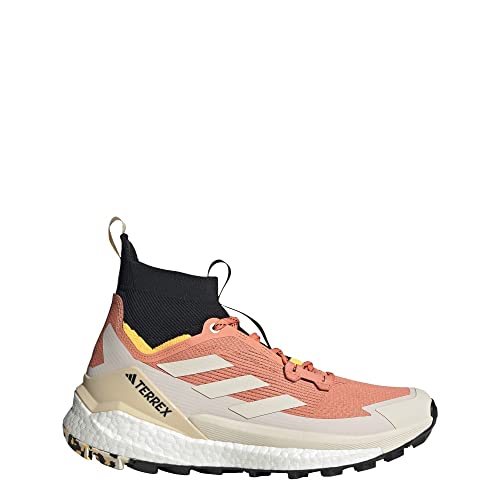
The adidas Mens Terrex Free Hiker 2 stands as the ideal choice for hikers who prioritize comfort and eco-conscious design without sacrificing performance on varied terrain. The BOOST midsole delivers exceptional cushioning and energy return from heel to toe. You’ll experience a sock-like fit through the seamless mesh upper construction. The Continental Rubber outsole provides reliable traction across muddy and rocky conditions. Environmental responsibility meets performance-the upper contains at least 50% Parley Ocean Plastic plus recycled polyester. Consider sizing up half a size if you’re replacing insoles. The design isn’t waterproof, so moisture management requires proper drying techniques for peak comfort.
Best For: Hikers seeking comfortable, eco-friendly footwear for everyday hikes and multiday trips who value cushioning and traction but don’t require waterproof protection.
Pros:
- BOOST midsole provides exceptional cushioning and energy return with sock-like fit from seamless mesh upper
- Continental Rubber outsole delivers reliable traction on muddy and rocky terrain with long-lasting durability
- Environmentally responsible construction using at least 50% Parley Ocean Plastic and recycled polyester
Cons:
- Not waterproof and moisture takes longer to escape, requiring proper drying techniques for comfort
- Cleaning can be challenging as the upper retains stains, especially in lighter colors
- Tight initial fit may require sizing up half a size and can take time to break in properly
Danner Trail 2650 Campo 3 Hiking Shoes for Men

When warm-weather hiking demands lightweight performance without sacrificing durability, Danner’s Trail 2650 Campo 3 delivers exceptional versatility for trail runners and day hikers. The PU-coated leather and textile upper features TPU overlays for enhanced durability. You’ll appreciate the lightweight mesh lining that maintains breathability during extended wear.
PlyoGo ultra-lightweight EVA midsole provides responsive cushioning. The removable OrthoLite footbed includes three supportive layers. Danner’s lightweight EXO Heel System incorporates an external counter for secure heel retention.
Vibram 460 outsole features self-adapting lugs with Megagrip compound for reliable traction on wet and dry surfaces. You’ll find dust-gaiter compatibility protects against trail debris. These shoes excel on easy to moderate terrain and work well for everyday casual wear beyond hiking applications.
Best For: Warm-weather hikers and trail runners seeking lightweight, breathable footwear for easy to moderate terrain and everyday casual wear.
Pros:
- Ultra-lightweight EVA midsole and breathable mesh lining provide excellent comfort for extended wear
- Vibram 460 outsole with Megagrip compound delivers reliable traction on both wet and dry surfaces
- Dust-gaiter compatibility and TPU overlays offer enhanced protection and durability for trail conditions
Cons:
- Mixed customer reviews regarding long-term durability, particularly with sole wear
- Some users report snugness in the elastic ankle cuff affecting overall fit
- May not provide adequate protection for challenging or technical terrain beyond moderate trails
Factors to Consider When Choosing Shoes for Hiking
I’ll guide you through five critical factors that determine whether hiking shoes will perform well on your adventures. These considerations form the foundation for making an informed purchase that matches your specific hiking needs and environmental conditions. Each factor directly impacts your comfort, safety, and overall trail experience, so I’ll examine how proper fit, terrain compatibility, support systems, weather protection, and build quality work together to create the ideal hiking shoe.
Proper Fit and Sizing
Although many hikers focus on features like waterproofing and tread patterns, proper fit and sizing remains the most critical factor in selecting hiking footwear. I recommend ordering half a size larger than your normal shoe size to accommodate foot swelling during extended hikes. Poor-fitting shoes cause blisters, hot spots, and painful pressure points that’ll ruin your trail experience.
A wide toe box is essential for natural foot splay, preventing conditions like hammertoes. When testing shoes, wear thick hiking socks to simulate actual trail conditions. This gives you an accurate assessment of the fit you’ll experience on the mountain.
Sizing varies greatly between manufacturers. I always check each brand’s specific sizing chart before purchasing, as a size 9 in one brand might fit like an 8.5 in another.
Terrain and Trail Type
Since terrain dictates the performance demands placed on your hiking footwear, you’ll need different outsole designs and construction features for various trail conditions. Rocky and muddy terrain requires specialized traction patterns with deep lugs for grip and stability. Rugged environments demand durable materials and reinforced construction to withstand sharp rock impacts and uneven ground stress.
Minimalist shoes work best on smooth, well-maintained trails where natural foot movement and enhanced proprioception matter more than heavy cushioning. However, steep inclines and slippery surfaces require additional ankle support and shock-absorbing midsoles.
Weather conditions are equally critical. Waterproof membranes become essential for muddy or wet trails, while breathable mesh materials suit dry, hot climates better. Match your shoe’s technical specifications directly to your planned hiking environment.
Support and Cushioning Needs
When choosing hiking shoes, your foot’s biomechanical needs determine the level of support and cushioning required for safe, comfortable trail performance. I recommend evaluating your specific conditions first. Plantar fasciitis and neuropathy require enhanced support systems to prevent further complications.
Arch support directly affects weight distribution across your foot. Proper alignment reduces strain on ligaments and tendons during extended hikes. However, I’ve found that balance matters. Overly rigid shoes restrict natural movement, while excessive cushioning compromises stability on uneven terrain.
Rocky trails demand more cushioning to absorb impact forces. Determine whether you need heel support or forefoot protection based on your hiking style. The midsole density affects both comfort and ground feedback. I suggest testing shoes with varying support levels to determine your ideal configuration for different trail conditions.
Weather and Water Resistance
Weather conditions directly dictate your hiking shoe’s material composition and waterproofing requirements. I recommend breathable materials for warm, dry climates to prevent overheating. Waterproof options become essential in wet or muddy environments, though they retain moisture longer than breathable alternatives.
Waterproof shoes use treated materials that perform effectively in shallow water. However, they don’t excel in heavy rain due to slower moisture escape rates. Look for ventilation features that regulate temperature without compromising water resistance.
Select shoes with drainage systems for wet conditions. These prevent water pooling inside, which causes discomfort and blisters. For rugged, rocky terrain, you’ll need footwear combining water resistance with aggressive tread patterns. This combination protects against slips on wet surfaces while maintaining durability.
Durability and Construction Quality
Water resistance means nothing if your shoes fall apart after a few challenging trails. I prioritize construction quality above flashy features when selecting hiking footwear.
Look for PU-coated leather uppers with reinforced seams at stress points. These materials resist abrasion while maintaining flexibility. I examine stitching density-quality shoes feature double or triple-stitched seams at the toe box and heel counter.
The outsole determines long-term performance. Vibram rubber compounds offer superior durability and traction on wet surfaces. I check for deep lug patterns that won’t wear smooth quickly.
Lightweight EVA midsoles provide cushioning without adding bulk. This reduces fatigue during extended hikes while maintaining structural integrity.
Proper maintenance extends shoe lifespan considerably. I clean boots after every hike, removing debris that can degrade materials over time.
On a final note
I’ve reviewed eight top-performing hiking shoes across different categories. You’ll find barefoot minimalist options like the Theora Pro HF provide maximum ground feel, while traditional models like the Danner Trail 2650 offer superior ankle support. Consider your terrain type, foot shape, and hiking distance before purchasing. Waterproof models work best for wet conditions, but breathable designs prevent overheating on longer treks. Choose based on your specific hiking requirements.

